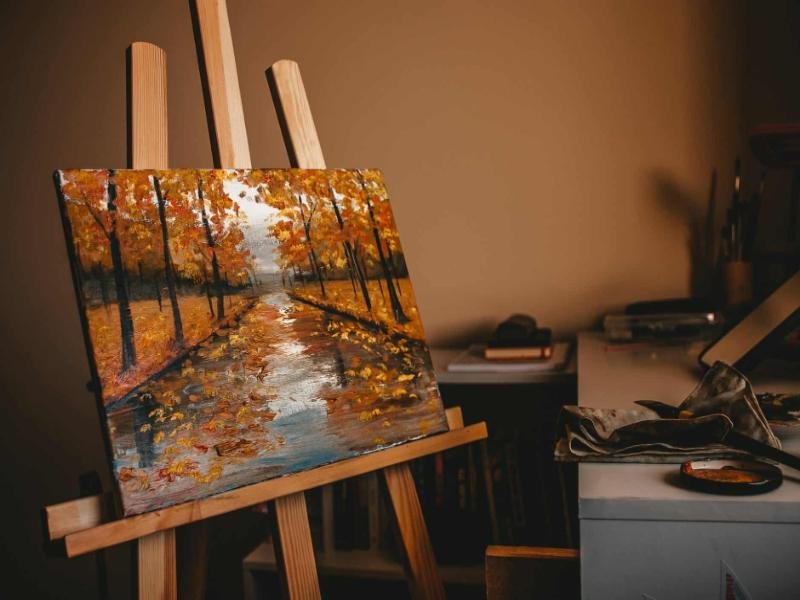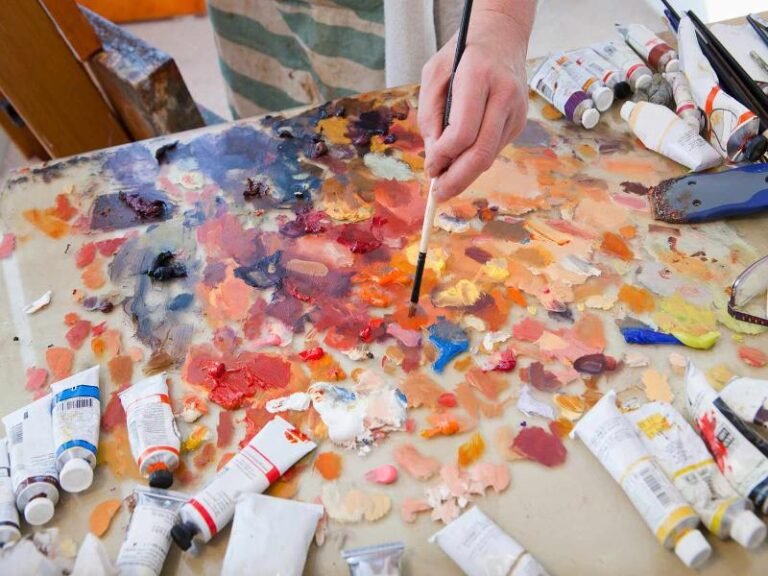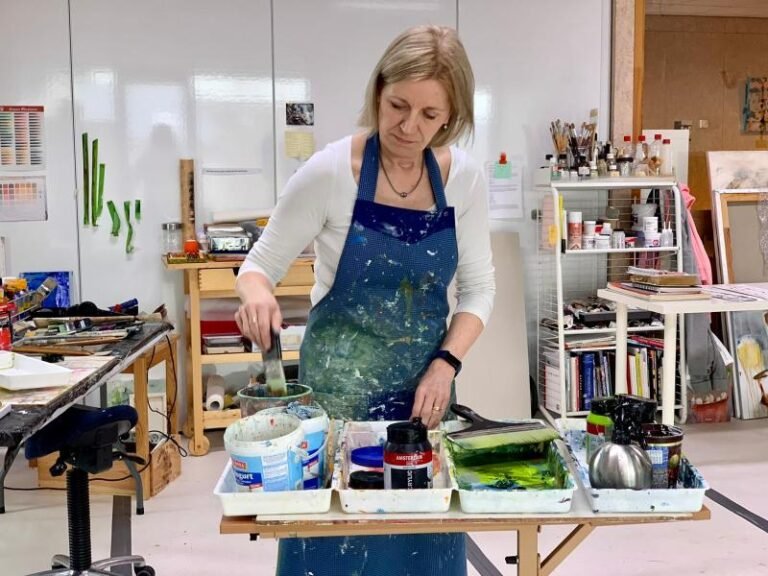Oil Painting for Beginners (Comprehensive Guide)
The Artistic Journey Begins
The Allure of Oil Painting
The allure of oil painting is embedded in its rich history and timeless appeal. The medium’s unique characteristics, such as the luminosity of colors and the ability to blend and layer, draw artists into a world where each stroke tells a story.
Oil paintings’ inherent depth and texture create a visual experience that transcends the limitations of other artistic mediums.
Unlocking Creativity Through Self-Expression
Oil painting serves as a powerful tool for self-expression, allowing artists to convey emotions, thoughts, and perspectives in a visually striking manner. The tactile nature of working with oil paints provides a hands-on experience that encourages exploration and experimentation.
As artists engage with the medium, they discover new facets of their creativity, unlocking a journey of self-expression that evolves with every brushstroke.
Oil Painting for Beginners (Getting Started)
Setting the Artistic Stage
1. Choosing the Right Canvas
The choice of canvas sets the stage for the artistic journey. Whether opting for a smooth canvas that lends itself to intricate details or a textured surface that adds depth and character, each canvas type imparts a unique quality to the final artwork.
Understanding the nuances of different canvases empowers artists to make intentional choices that align with their artistic vision.
How to Mix Colors for Oil Painting
2. Exploring Textures: Smooth vs. Textured
Delving into the world of textures involves understanding how they contribute to the overall aesthetic of a painting. Smooth canvases provide a clean and polished look, ideal for certain styles, while textured surfaces introduce an element of dynamism and interest.
Artists navigate this choice based on the desired visual impact and the narrative they aim to convey.
3. Selecting the Essential Brushes
The journey begins with a careful selection of brushes, each with its role in bringing the canvas to life. Diverse shapes and sizes cater to various strokes and techniques, enabling artists to execute everything from broad, sweeping gestures to intricate details with precision.
The right brushes become an extension of the artist’s hand, facilitating the translation of creative ideas onto the canvas.
Crafting Your Palette
Limited Color Palette for Beginners
Navigating the vast spectrum of colors begins with a mindful approach. Limiting the color palette initially helps beginners focus on mastering essential skills such as color mixing and brush control.
This intentional restraint fosters a deeper understanding of how colors interact and allows for a more gradual and manageable learning curve.
Exploring Primary Colors and Variations
The journey into color exploration involves understanding the basics, starting with primary colors. Exploring the variations within these foundational hues provides a solid foundation for creating a wide array of tones and shades.
Artists embark on a journey of discovery, experimenting with the endless possibilities that arise from the subtle interplay of primary colors.
Techniques for Beginners
Mastering Basic Brushstrokes
1. The Foundation of Brushwork
Mastering basic brushstrokes is akin to building the foundation of an artwork. Understanding the different types of strokes and their applications lays the groundwork for artistic expression. Each stroke contributes to the overall composition, shaping the visual narrative of the painting.
2. Long Strokes for Sweeping Landscapes
Long, sweeping strokes are instrumental in capturing the grandeur of landscapes. Whether depicting expansive skies or rolling hills, the use of long strokes imparts a sense of movement and scale to the composition. Artists harness this technique to convey vastness and create immersive scenes.
3. Short, Controlled Strokes for Intricate Details
In contrast, short and controlled strokes become the brushwork of choice when delving into intricate details. This technique is indispensable for adding precision to elements such as fine lines, textures, and intricate patterns. It grants artists the ability to focus on specific aspects of the composition, enhancing the overall visual richness.
Embracing the Power of Layers
1. Dimension and Depth Through Layering
Embracing the power of layers introduces a dynamic element to oil painting. Layering allows artists to build dimension and depth within their artwork, creating a multi-dimensional visual experience. This technique transforms a two-dimensional canvas into a compelling and textured representation of the artist’s vision.
2. Application of Thin Layers for Transparency
Thin layers play a pivotal role in achieving transparency within an oil painting. Applied strategically, these layers allow underlying colors to show through, creating a luminous effect. Artists use this technique to convey a sense of lightness or translucency, adding nuance and complexity to their compositions.
3. Building Thicker Layers for Depth and Richness
Conversely, building thicker layers imparts a sense of solidity and richness to the artwork. This technique involves applying paint more generously, and creating pronounced textures and tactile surfaces. Artists use this method to emphasize focal points, add weight to elements, and enhance the overall tactile quality of their paintings.
Troubleshooting Common Challenges
Overcoming Drying Time Dilemmas
1. The Virtue of Patience in Oil Painting
Patience is more than a virtue; it is a cornerstone of success in oil painting. The medium’s inherent slow-drying nature requires artists to embrace the unfolding of their artistic vision over time. Waiting allows layers to settle, preventing unintentional blending and ensuring the integrity of the final piece.
2. Understanding Drying Times
Understanding the intricacies of drying times is essential for mastery in oil painting. Factors such as temperature, humidity, and the specific colors used influence how quickly or slowly paint dries. Artists keenly observe and adapt to these variables, allowing them to anticipate and navigate the unique drying characteristics of their chosen pigments.
3. Exploring Drying Mediums and Techniques
To navigate the nuances of drying times, artists often explore various drying mediums and techniques. Drying mediums can expedite or extend the drying process, providing artists with a level of control over the pace of their work. Techniques such as underpainting or layering offer additional strategies to manage drying times effectively.
Navigating Color Mixing Conundrums
1. Thrills and Challenges of Color Mixing
Color mixing is both thrilling and challenging, offering a vast palette of possibilities while requiring a nuanced understanding of hues, tones, and shades. Artists embrace the adventure of creating unique colors, experimenting with different combinations to evoke specific moods and atmospheres in their paintings.
2. Utilizing the Color Wheel as a Guide
The color wheel serves as an indispensable guide for navigating the complexities of color mixing. Understanding the relationships between primary, secondary, and tertiary colors empowers artists to make informed choices. By strategically using the color wheel, artists achieve harmonious color schemes that enhance the visual impact of their artwork.
3. Avoiding Overmixing for Color Vibrancy
While experimentation is encouraged, avoiding overmixing is crucial for preserving color vibrancy. Overmixing can result in muddied tones and diminished visual impact. Artists exercise restraint, allowing for the subtleties of mixed colors to shine through and maintain the brilliance that makes oil paintings truly captivating.
Advanced Tips for Progression
Experimenting with Texture
1. Adding Texture for Visual Interest
Elevate your oil paintings by introducing texture for a visually compelling experience. The tactile quality of textured surfaces adds depth and engages viewers on a sensory level. Experiment with different materials and techniques to discover the endless possibilities of texture in your artistic repertoire.
2. Impasto Techniques for a Three-Dimensional Effect
Impasto, a technique involving thick applications of paint, brings paintings to life with a three-dimensional effect. Artists use palette knives or brushes to create raised areas on the canvas, adding a sculptural quality to the artwork. This technique not only enhances visual interest but also invites a tactile exploration of the painting’s surface.
3. Exploring Different Palette Knife Strokes
Palette knives are versatile tools that open up a realm of expressive possibilities. Experiment with various palette knife strokes to create unique textures and effects. Whether it’s creating bold, sweeping gestures or intricate patterns, the palette knife becomes an extension of the artist’s hand, offering a dynamic way to convey artistic vision.
Enhancing Realism with Glazing
Achieving Luminosity and Depth Through Glazing
Glazing is a sophisticated technique that imparts luminosity and depth to oil paintings. Transparent layers of glaze applied over dry paint allow underlying colors to subtly shine through. This method is particularly effective for creating a sense of light, atmosphere, and realism in your artwork.
Selecting Suitable Glazing Mediums
Choosing the right glazing medium is pivotal in achieving the desired effects. Various mediums, such as linseed oil or alkyd resin, offer different viscosities and drying times. Artists carefully select glazing mediums based on their desired outcomes, ensuring compatibility with the chosen pigments and maintaining the integrity of the glazing process.
Layering Transparent Glazes for Desired Effects
Layering transparent glazes requires a meticulous approach to build desired effects gradually. Artists strategically apply thin layers of glaze, allowing each one to dry before adding the next. This method enhances color vibrancy, creates subtle shifts in hue, and contributes to the overall complexity of the painting.
Conclusion
As you progress in your oil painting journey, take a moment to celebrate the growth and evolution of your artistic skills. Each stroke on the canvas represents a step forward, a testament to your dedication, and a marker of the unique creative process that defines your artistic identity.
Acknowledge the significance of each stroke, recognizing that it contributes to the narrative of your artistic expression. Every brushstroke tells a story, capturing moments of inspiration, challenges overcome, and the continuous refinement of your craft. Embrace the imperfections, for they are an integral part of your artistic journey.
As you paint the path forward, let curiosity be your guide. Embrace continued exploration and practice as essential components of artistic development. Your journey in oil painting is a dynamic process, and each canvas is an opportunity to push boundaries, refine techniques, and discover the boundless possibilities that lie ahead.
Happy painting!





